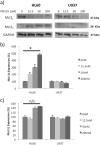AML sensitivity to YM155 is modulated through AKT and Mcl-1
- PMID: 26118775
- PMCID: PMC4545294
- DOI: 10.1016/j.canlet.2015.05.034
AML sensitivity to YM155 is modulated through AKT and Mcl-1
Abstract
HL60 and U937 (acute myeloid leukemia (AML) cell lines) were assessed for sensitivity to YM155, and found to have distinct sensitive and resistant phenotypes, respectively. In HL60 cells, YM155 inhibition of growth proliferation was due to apoptosis which was measured by annexin V/PI staining. YM155 induced apoptosis through activation of intrinsic and extrinsic pathways that also culminated in caspase-3 activity and PARP cleavage. YM155 sensitivity was partially associated with this compound's ability to down-regulate survivin transcription since this was more pronounced in the HL60 cell line. However, marked differences were also observed in XIAP, Bcl-2, and Mcl-1L, and Mcl-1s. Furthermore, YM155 treatment completely inhibited production of total Akt protein in HL60, but not U937 cells. Importantly, Akt activity (pAkt-Ser473) levels were maintained in YM155 treated U937 cells which may help stabilize other anti-apoptotic proteins. Combination treatments with an Akt inhibitor, MK-2206, reduced levels of pAkt-Ser473 in U937 cells and synergistically sensitized them to YM155 cytotoxicity. Collectively our results indicate that Akt signaling may be an important factor mediating YM155 response in AML, and combinatorial therapies with Akt inhibitors could improve treatment efficacy in YM155-resistant cells.
Keywords: AML; Akt; Bcl-2; Mcl-1; XIAP; YM155.
Copyright © 2015 Elsevier Ireland Ltd. All rights reserved.
Conflict of interest statement
All authors declare that they have no conflicts of interest.
Figures








References
-
- Siegel RL, Miller KD, Jemal A. Cancer statistics, 2015. CA Cancer J Clin. 2015;65:5–29. - PubMed
-
- Yanada M, Naoe T. Acute myeloid leukemia in older adults. Int J Hematol. 2012;96:186–193. - PubMed
-
- Fernandez HF. New trends in the standard of care for initial therapy of acute myeloid leukemia. Hematology Am Soc Hematol Educ Program. 2010;2010:56–61. - PubMed
Publication types
MeSH terms
Substances
Grants and funding
LinkOut - more resources
Full Text Sources
Other Literature Sources
Medical
Research Materials
Miscellaneous

